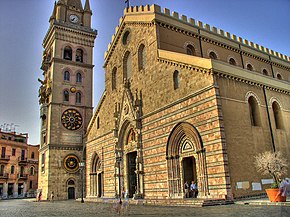You can help expand this article with text translated from the corresponding article in Italian. (September 2015) Click [show] for important translation instructions.
|
Messina Cathedral (Italian: Duomo di Messina; Basilica Cathedrale metropolitana di Santa Maria Assunta) is a Roman Catholic cathedral located in Messina, Sicily. Formerly the episcopal seat of the Diocese of Messina, it became in 1986 the archiepiscopal seat of the Archdiocese of Messina-Lipari-Santa Lucia del Mela.

In June 1947 Pope Pius XII granted it the status of a minor basilica.
Built by the Normans, it was consecrated in 1197 by the Archbishop Berardo. Henry VI, Holy Roman Emperor and Constance I of Sicily were present to witness the ceremony. The current building is the final result of some twentieth-century reconstructions, which took place following the disastrous earthquake that struck Messina in 1908 and the considerable damage that resulted from the heavy aerial bombardment in World War II.[1]
Only the perimeter walls, the Gothic portal and an apse remained standing after the catastrophic earthquake which also destroyed surrounding edifices in Piazza Duomo. In 1943 incendiary bombs fell on the restored roof destroying much of its interior. Only an original mosaic and statue survived.
The tower houses the Messina astronomical clock, the largest astronomical clock in the world.
History
editVarious calamities, and in particular earthquakes , have struck the city several times over the centuries, damaging or destroying its monuments. The bell tower of the Cathedral is no exception to the rule.
Since the 12th century it has served merely decorative and liturgical purposes; in fact, it is enough to move a few dozen metres upstream to have a perfect panoramic view of the entire area of the Strait with a view of Calabria and a large portion of the Ionian Sea on the horizon .
- 1559 , Struck by lightning, it caught fire and was rebuilt by Martino da Firenze , reconstruction activity continued in 1564 by Andrea Calamech .
Until 1678 (the year of the end of the anti-Spanish revolt and the signing of the Peace of Nijmegen , with which the city was reconquered by Spain ), the base of the bell tower housed precious parchment documents containing the historical memories of the city, brought to Spain to the monastery of El Escorial along with many other works of art.
- 1693 , Further damage was caused by the two earthquakes in the Val di Noto which in January affected the whole of eastern Sicily.
- 1783 , The numerous seismic shocks of the southern Calabria earthquake in February destroyed it, causing the collapse of the upper orders. To adapt the structure of the temple to the changing taste of the time, the squat bell tower was destroyed in 1863 and in its place two neo-Gothic towers were erected above the lateral apses.
The current bell tower was rebuilt in its original location after the 1908 earthquake and was designed based on the old one. More than 65 metres high, in the shape of a tower with a cusp roof, lightened on all sides by pairs of mullioned windows with pointed arches, it contains a magnificent animated clock, a true mechanical jewel, commissioned by Archbishop Angelo Paino from the Ungerer company of Strasbourg in 1933. This system is considered the largest and most complex mechanical and astronomical clock in the world.
Bells
editThe bell tower contains the largest concert in all of Sicily, consisting of 8 bells tuned according to the F#2 ascending major diatonic scale , all cast by the Colbachini foundry of Padua in 1929. The first, third and fifth bells are electrified in the fast Veronese style (without the possibility of going to the cup, however) while the others are fixed but are equipped with hammers. There are 2 other fixed bells, cast by Micheal Salicula in 1400. They were saved from the terrible Messina earthquake of 1908 .
See also
editReferences
edit- ^ Giovanni Bonanno. Cattedrali di Sicilia. M. Grispo, 2000.
External links
editMedia related to Messina Cathedral at Wikimedia Commons